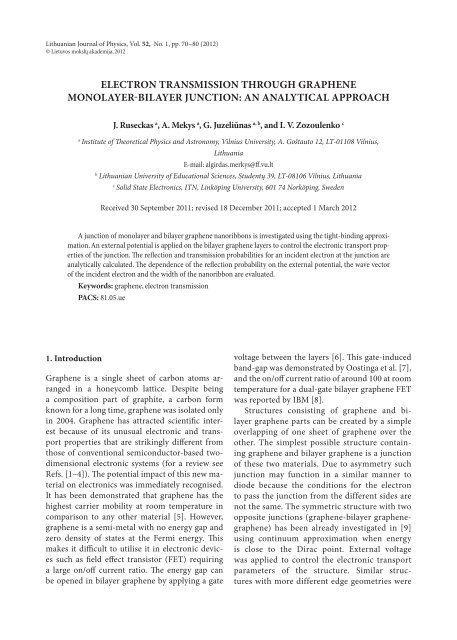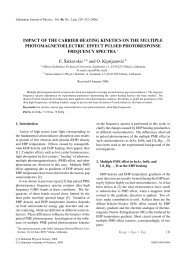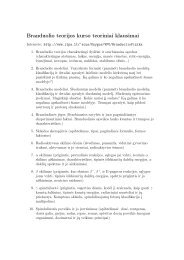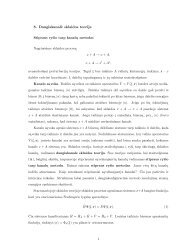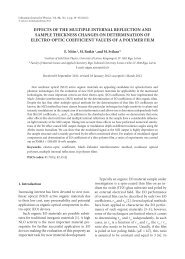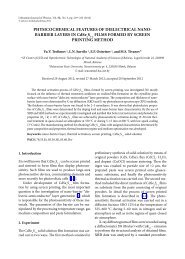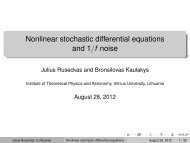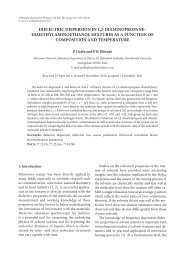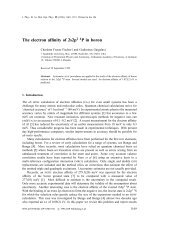electron transmission through graphene monolayer-bilayer junction
electron transmission through graphene monolayer-bilayer junction
electron transmission through graphene monolayer-bilayer junction
You also want an ePaper? Increase the reach of your titles
YUMPU automatically turns print PDFs into web optimized ePapers that Google loves.
Lithuanian Journal of Physics, Vol. 52, No. 1, pp. 70–80 (2012)<br />
© Lietuvos mokslų akademija, 2012<br />
ELECTRON TRANSMISSION THROUGH GRAPHENE<br />
MONOLAYER-BILAYER JUNCTION: AN ANALYTICAL APPROACH<br />
J. Ruseckas a , A. Mekys a , G. Juzeliūnas a, b , and I. V. Zozoulenko c<br />
a<br />
Institute of Theoretical Physics and Astronomy, Vilnius University, A. Goštauto 12, LT-01108 Vilnius,<br />
Lithuania<br />
E-mail: algirdas.merkys@ff.vu.lt<br />
b<br />
Lithuanian University of Educational Sciences, Studentų 39, LT-08106 Vilnius, Lithuania<br />
c<br />
Solid State Electronics, ITN, Linköping University, 601 74 Norköping, Sweden<br />
Received 30 September 2011; revised 18 December 2011; accepted 1 March 2012<br />
A <strong>junction</strong> of <strong>monolayer</strong> and <strong>bilayer</strong> <strong>graphene</strong> nanoribbons is investigated using the tight-binding approximation.<br />
An external potential is applied on the <strong>bilayer</strong> <strong>graphene</strong> layers to control the <strong>electron</strong>ic transport properties<br />
of the <strong>junction</strong>. The reflection and <strong>transmission</strong> probabilities for an incident <strong>electron</strong> at the <strong>junction</strong> are<br />
analytically calculated. The dependence of the reflection probability on the external potential, the wave vector<br />
of the incident <strong>electron</strong> and the width of the nanoribbon are evaluated.<br />
Keywords: <strong>graphene</strong>, <strong>electron</strong> <strong>transmission</strong><br />
PACS: 81.05.ue<br />
1. Introduction<br />
Graphene is a single sheet of carbon atoms arranged<br />
in a honeycomb lattice. Despite being<br />
a composition part of graphite, a carbon form<br />
known for a long time, <strong>graphene</strong> was isolated only<br />
in 2004. Graphene has attracted scientific interest<br />
because of its unusual <strong>electron</strong>ic and transport<br />
properties that are strikingly different from<br />
those of conventional semiconductor-based twodimensional<br />
<strong>electron</strong>ic systems (for a review see<br />
Refs. [1–4]). The potential impact of this new material<br />
on <strong>electron</strong>ics was immediately recognised.<br />
It has been demonstrated that <strong>graphene</strong> has the<br />
highest carrier mobility at room temperature in<br />
comparison to any other material [5]. However,<br />
<strong>graphene</strong> is a semi-metal with no energy gap and<br />
zero density of states at the Fermi energy. This<br />
makes it difficult to utilise it in <strong>electron</strong>ic devices<br />
such as field effect transistor (FET) requiring<br />
a large on/off current ratio. The energy gap can<br />
be opened in <strong>bilayer</strong> <strong>graphene</strong> by applying a gate<br />
voltage between the layers [6]. This gate-induced<br />
band-gap was demonstrated by Oostinga et al. [7],<br />
and the on/off current ratio of around 100 at room<br />
temperature for a dual-gate <strong>bilayer</strong> <strong>graphene</strong> FET<br />
was reported by IBM [8].<br />
Structures consisting of <strong>graphene</strong> and <strong>bilayer</strong><br />
<strong>graphene</strong> parts can be created by a simple<br />
overlapping of one sheet of <strong>graphene</strong> over the<br />
other. The simplest possible structure containing<br />
<strong>graphene</strong> and <strong>bilayer</strong> <strong>graphene</strong> is a <strong>junction</strong><br />
of these two materials. Due to asymmetry such<br />
<strong>junction</strong> may function in a similar manner to<br />
diode because the conditions for the <strong>electron</strong><br />
to pass the <strong>junction</strong> from the different sides are<br />
not the same. The symmetric structure with two<br />
opposite <strong>junction</strong>s (<strong>graphene</strong>-<strong>bilayer</strong> <strong>graphene</strong><strong>graphene</strong>)<br />
has been already investigated in [9]<br />
using continuum approximation when energy<br />
is close to the Dirac point. External voltage<br />
was applied to control the <strong>electron</strong>ic transport<br />
parameters of the structure. Similar structures<br />
with more different edge geometries were
J. Ruseckas et al. / Lith. J. Phys. 52, 70–80 (2012) 71<br />
investigated in [10]. The investigation was also limited<br />
to the continuum approximation without application<br />
of the external voltage. In our work we use<br />
the tight-binding approximation, which allows us<br />
to investigate the system properties for the whole<br />
energy range. The deficiency of the tight-binding<br />
approximation is the neglection of higher order<br />
corrections, which include the <strong>graphene</strong> nanoribbon<br />
(GNR) bending effect or its conversion into the<br />
nanotube. In this way it becomes indistinguishable<br />
if we have an infinite nanotube with a semi-infinite<br />
nanotube inside or an infinite nanotube is inserted<br />
into another semi-infinite nanotube.<br />
An additional insight into <strong>electron</strong>ic properties<br />
of <strong>graphene</strong> and GNRs can be obtained from exact<br />
analytical approaches. Analytic calculations for the<br />
<strong>electron</strong>ic structure of the GNRs have been reported<br />
in Refs. [11–15]. The <strong>electron</strong>ic structure of <strong>bilayer</strong><br />
<strong>graphene</strong> was addressed in Refs. [16–20] where the<br />
analytical results were presented (both exact and<br />
perturbative). The <strong>electron</strong>ic structure of <strong>bilayer</strong><br />
GNRs was analytically obtained in [21]. A numerical<br />
study of the magnetobandstructure of the GNRs<br />
was reported in Ref. [22, 23], and the numerical<br />
treatment of the edge states in the <strong>bilayer</strong> GNRs was<br />
presented in Ref. [20]. The aim of the present study<br />
is to provide an exact analytical description of the π<br />
<strong>electron</strong> reflection and <strong>transmission</strong> in the <strong>junction</strong><br />
of the <strong>bilayer</strong> and <strong>monolayer</strong> nanoribbons with armchair<br />
edges, with applied external potential.<br />
The paper is organised as follows: in Sec. 2 we<br />
present the known analytical results of <strong>monolayer</strong><br />
and <strong>bilayer</strong> <strong>graphene</strong> and construct the wave function<br />
for the <strong>junction</strong>. Subsequently in Sec. 3 we analyse<br />
the properties of the <strong>electron</strong>ic <strong>transmission</strong><br />
<strong>through</strong> the <strong>junction</strong>. Finally, Sec. 4 summarises<br />
our findings.<br />
2. Analytical expressions of the <strong>electron</strong>ic states<br />
at the <strong>junction</strong><br />
Analytical expressions for the <strong>electron</strong> spectrum<br />
in GNRs and <strong>graphene</strong> nanotubes (GNTs), based<br />
on a tight-binding model, were provided in Ref.<br />
[14] and the expressions for <strong>bilayer</strong> <strong>graphene</strong> were<br />
provided in Ref. [21]. In this section we exploit<br />
these expressions to construct the wave function<br />
for the system of <strong>graphene</strong> connected to <strong>bilayer</strong><br />
<strong>graphene</strong>. One may consider this system as a single<br />
infinite length <strong>graphene</strong> ribbon with another<br />
semi-infinite <strong>graphene</strong> ribbon overlapping, but<br />
mathematically it is simpler to consider the system<br />
as a <strong>junction</strong> of semi-infinite <strong>graphene</strong> with<br />
semi-infinite <strong>bilayer</strong> <strong>graphene</strong> ribbons. For simplicity,<br />
we analyse in this work only AB-α stacking<br />
of <strong>bilayer</strong> <strong>graphene</strong>, as shown in Fig. 1, and other<br />
configurations are left for the future calculations.<br />
Also, the atoms at the <strong>junction</strong> edge are arranged<br />
in a zigzag configuration, while the sides of the<br />
ribbon are in the armchair configuration of the<br />
atoms.<br />
We consider π <strong>electron</strong> spectrum in an infinite<br />
sheet of <strong>graphene</strong>. The structure of <strong>graphene</strong> can<br />
be viewed as a hexagonal lattice with a basis of two<br />
Fig. 1. (Colour online) (a) Sub-lattices A 1<br />
, A 2<br />
, B 1<br />
, B 2<br />
on <strong>bilayer</strong> <strong>graphene</strong> in AB-α stacking. (b) Indication of labels of<br />
carbon atom cells used for <strong>bilayer</strong> <strong>graphene</strong>.
72<br />
J. Ruseckas et al. / Lith. J. Phys. 52, 70–80 (2012)<br />
atoms per unit cell. The Cartesian components of<br />
the lattice vectors a 1<br />
and a 2<br />
are a(³₂, √³₂) and a(³₂,<br />
–√³₂), respectively. Here a ≈ 1.42 is the carboncarbon<br />
distance [1]. The three nearest-neighbour<br />
vectors are given by δ 1<br />
= a(¹₂, √³₂) , δ 2<br />
= a(¹₂,<br />
–√³₂), and δ 3<br />
= a(–1,0). The tight-binding Hamiltonian<br />
for <strong>electron</strong>s in <strong>graphene</strong> has the form<br />
(1)<br />
where the operators a i<br />
and b i<br />
annihilate an <strong>electron</strong><br />
on sub-lattice A at site R i<br />
A<br />
and on sub-lattice<br />
B at site R iB<br />
, respectively (for single <strong>graphene</strong> consider<br />
Fig. 1 with A 1<br />
= A and B 1<br />
= B). The parameter<br />
t is the nearest-neighbour hopping energy<br />
(t ≈ 2.8 eV). Hereinafter all energies will be written<br />
in the units of the hopping integral t, therefore<br />
we set t = 1. Let us label the elementary cells of<br />
the lattice with two numbers p and q. Then the<br />
atoms in the sub-lattices A and B are positioned at<br />
A<br />
B<br />
R p ,q<br />
= pa 1<br />
+ qa 2<br />
and R p ,q<br />
=δ 1<br />
+ pa 1<br />
+ qa 2<br />
respectively.<br />
The π <strong>electron</strong> wave function satisfies the<br />
Schrödinger equation<br />
HΨ = EΨ. (2)<br />
We search for the eigenvectors of the Hamiltonian<br />
(1) in the form of the plane waves (Bloch states) by<br />
taking the probability amplitudes to find an atom<br />
A<br />
B<br />
in the sites R p, ,q<br />
and R p ,q<br />
of the sub-lattices A and<br />
B as<br />
(3)<br />
Thus Eq. (2) yields the eigenvalue equations for<br />
the coefficients c A and c B (envelope functions):<br />
where<br />
–Ec A = c B ϕ˜ (k) , (4)<br />
– Ec B = c A ϕ˜ (–k) , (5)<br />
ϕ˜ (k) ≡ e ik·δ 1 + e ik·δ 2 + e ik·δ 3 . (6)<br />
Further we will consider the spectrum of π <strong>electron</strong>s<br />
in an infinite sheet of <strong>bilayer</strong> <strong>graphene</strong>. The<br />
tight-binding Hamiltonian for <strong>electron</strong>s in <strong>bilayer</strong><br />
<strong>graphene</strong> has the following form:<br />
(7)<br />
where the operators a i, p<br />
and b i, p<br />
annihilate an<br />
<strong>electron</strong> on sub-lattice A p<br />
at site R i<br />
A p<br />
and on sublattice<br />
B p<br />
at site R i<br />
B p<br />
respectively (Fig. 1). The index<br />
p = 1,2 numbers the layers in the <strong>bilayer</strong> system.<br />
In the Hamiltonian (7) we neglected the terms<br />
corresponding to the hopping between atom B 1<br />
and atom B 2<br />
, with the hopping energy γ 3<br />
, and the<br />
terms corresponding to the hopping between atom<br />
A 1<br />
(A 2<br />
) and atom B 2<br />
(B 1<br />
) with the hopping energy<br />
γ 4<br />
. The neglect of these hopping terms leads to the<br />
minimal model of <strong>bilayer</strong> <strong>graphene</strong> [19]. The parameter<br />
t^<br />
(t^≈ 0.4 eV) is the hopping energy between<br />
atom A 1<br />
and atom A 2<br />
while V is half the shift<br />
in the electro-chemical potential between the two<br />
layers. Similarly as in <strong>monolayer</strong> <strong>graphene</strong>, we express<br />
all the energies in the units of t. The atoms in<br />
the sub-lattices A 1<br />
and A 2<br />
are positioned at R p,<br />
A,q 1,2 =<br />
pa 1<br />
+ qa 2<br />
, in the sub-lattice B 1<br />
the aptoms are positioned<br />
at R p<br />
B,q 1 = δ 1<br />
+ pa 1<br />
+ qa 2<br />
and in the sub-lattice<br />
B 2<br />
the atoms are positioned at R p<br />
B,q 2 = –δ 1<br />
+ pa 1<br />
+ qa 2<br />
.<br />
We search for the eigenvectors of the Hamiltonian<br />
(7) in the form of the plane waves. The probability<br />
amplitudes to find an atom in the sites R p,<br />
A,q 1,2 and<br />
R p,<br />
B,q 1,2 of the sub-lattices A j<br />
and A j<br />
are:<br />
(8)<br />
The coefficients (envelope functions) c A p and c B p<br />
obey the eigenvalue equations:<br />
–Ec A 1 = Vc A 1 + c B 1 ϕ˜ (k) + γc A 2<br />
, (9)<br />
–Ec B 1 = Vc B 1 + c A 1 ϕ˜ (–k) , (10)<br />
–Ec A 2 = –Vc A 2 + c B 2 ϕ˜ (–k) + γc A 1<br />
, (11)<br />
–Ec B 2 = –Vc B 2 + c A 2 ϕ˜ (k) . (12)
J. Ruseckas et al. / Lith. J. Phys. 52, 70–80 (2012) 73<br />
Here energy E, potential V, and interaction between<br />
layers γ ≡ t^/t are in the units of the hopping<br />
integral t. Using the nearest-neighbour hopping<br />
energy t ≈ 2.8 eV and the hopping energy between<br />
two layers t^<br />
≈ 0.4 eV, one gets γ ≈ 0.14.<br />
2.1. Electron spectrum in the infinite sheet of<br />
<strong>graphene</strong><br />
Since we are interested in configurations of <strong>graphene</strong><br />
with rectangular geometry, we use a rectangular<br />
unit cell as in Ref. [14] and follow the names<br />
of the variables and functions used in Ref. [21].<br />
Such unit cell has four atoms labelled with symbols<br />
l, λ, ρ, r, as shown in Fig. 1 (consider at this point<br />
only one layer with the labels l 1<br />
, λ 1<br />
, ρ 1<br />
, r 1<br />
, A 1<br />
, B 1<br />
).<br />
The atoms with labels l and ρ belong to the sublattice<br />
A, the atoms with labels λ and r belong to the<br />
sub-lattice B. The position of the unit cell is indicated<br />
with two numbers, n and m. The first Brillouin zone<br />
corresponding to the rectangular unit cell contains<br />
the values of the wave vectors κ, ξ. The eigenvectors<br />
describing the system have the form of plane waves:<br />
The zero energy points have coordinates<br />
in the Brillouin zone corresponding to the rectangular<br />
unit cell.<br />
Since we consider finite-size <strong>graphene</strong> sheets,<br />
evanescent solutions become important. We assume<br />
that exponentially decreasing or increasing<br />
solution can be obtained by taking κ = i|κ| or ξ = i|ξ|<br />
in Eqs. (14), (15) and (17).<br />
2.2. Electron spectrum in the infinite sheet of <strong>bilayer</strong><br />
<strong>graphene</strong><br />
The form of the wave function is similar to <strong>monolayer</strong><br />
<strong>graphene</strong>, Eq. (13), only the labels change:<br />
ψ m,n,αp<br />
(κ, ξ) = c αp<br />
(κ, ξ)e iξm+iκn , (18)<br />
Here the label p = 1, 2 is the number of the layer. The<br />
coefficients of the eigenvectors are (from Ref. [21]):<br />
(19)<br />
ψ m,n,α (κ, ξ) = c α<br />
(κ, ξ)e iξm+iκ , (13)<br />
where α = l, ρ, λ, r.<br />
The coefficients of the eigenvectors are:<br />
(20)<br />
c r<br />
= 1, (14)<br />
(15)<br />
(21)<br />
where<br />
(16)<br />
(22)<br />
and s 3<br />
= ±1 indicates the dispersion branches that<br />
appear due to a smaller Brillouin zone (for more<br />
details see Ref. [21]). The energy is (with s 1<br />
= ±1):<br />
Here s 1<br />
, s 2<br />
= ±1 are the sign coefficients:<br />
(23)<br />
(17)<br />
and the expression for energy is
74<br />
J. Ruseckas et al. / Lith. J. Phys. 52, 70–80 (2012)<br />
(24)<br />
The function ϕ(κ, ξ) has the same expression as<br />
Eq. (16), and V is the electrostatic potential applied<br />
on one layer of <strong>bilayer</strong> <strong>graphene</strong>, while –V is applied<br />
on the other. The parameter γ describes the<br />
interaction between the layers in <strong>bilayer</strong> <strong>graphene</strong>,<br />
γ = 0.14, measured in the same units as energy.<br />
In <strong>bilayer</strong> <strong>graphene</strong> there are two eigenstates<br />
with wave vectors κ (1) and κ (2) , having different absolute<br />
values but corresponding to the same energy:<br />
E (κ (1) , ξ) = E (κ (2) , ξ). One or both of the wave<br />
vectors κ (1) , κ (2) can be imaginary. The energy can be<br />
equal only if the signs s 1<br />
, s 2<br />
obey the condition<br />
we get that |ϕ| 2 is a complex number. This means<br />
that κ is also a complex number and has both real<br />
and imaginary parts.<br />
We have that<br />
(28)<br />
therefore, the dimesnionless x-component of the<br />
wave vector κ can be expressed as<br />
(29)<br />
s 1<br />
(2)<br />
s 2<br />
(2)<br />
= –s 1<br />
(1)<br />
s 2<br />
(1)<br />
. (25)<br />
It has to be noted that the sign coefficients from the<br />
set s 1<br />
, s 2<br />
, s 3<br />
in <strong>bilayer</strong> <strong>graphene</strong> are not necessary,<br />
the same as in the single <strong>graphene</strong> equations.<br />
In addition to the propagating waves, for finitesize<br />
<strong>bilayer</strong> <strong>graphene</strong> sheets evanescent solutions<br />
become important. We assume that exponentially<br />
decreasing or increasing solution can be obtained<br />
by taking κ = i|κ| or ξ = i|ξ|. In addition to the purely<br />
imaginary ξ there are solutions, corresponding to<br />
s 3<br />
= –1, having complex values of ξ.<br />
2.3. Calculation of wave vector from energy<br />
From the dispersion of <strong>bilayer</strong> <strong>graphene</strong> (Eq. (24))<br />
we obtain<br />
The indices s 1<br />
and s 1<br />
can be calculated from the<br />
equations (derived from Eq. (26))<br />
and<br />
(30)<br />
(31)<br />
(26)<br />
From this dispersion equation we find the expression<br />
for |ϕ| 2 :<br />
It should be noted that when<br />
(27)<br />
2.4. Construction of wave functions for the <strong>junction</strong><br />
The <strong>graphene</strong> and <strong>bilayer</strong> <strong>graphene</strong> <strong>junction</strong> is constructed<br />
as shown in Fig. 2. The unit cells (indicated<br />
with two numbers n and m) are the same both<br />
for <strong>graphene</strong> and <strong>bilayer</strong> <strong>graphene</strong>, just starting at<br />
a certain cell n (we choose: n < 0) the upper layer
J. Ruseckas et al. / Lith. J. Phys. 52, 70–80 (2012) 75<br />
Fig. 2. (Colour online) Perspective view of the <strong>graphene</strong>-<strong>bilayer</strong> <strong>graphene</strong> <strong>junction</strong>. The upper layer is connected<br />
to the potential +V, while the lower layer to the potential –V.<br />
of <strong>bilayer</strong> <strong>graphene</strong> is removed. Mathematically the<br />
condition for the absence of the second layer is:<br />
ψ m,n,α2<br />
(κ, ξ) = 0, n < 0. (32)<br />
In particular, at the boundary<br />
ψ m,-1,l2<br />
(κ, ξ) = 0. (33)<br />
The condition for connecting <strong>monolayer</strong> <strong>graphene</strong><br />
and <strong>bilayer</strong> <strong>graphene</strong> solutions is that amplitudes of<br />
<strong>monolayer</strong> and <strong>bilayer</strong> <strong>graphene</strong> should coincide:<br />
ψ m,0,λ<br />
(κ, ξ) = ψ m,0,λ1<br />
(κ, ξ), (34)<br />
The form of the solution in <strong>monolayer</strong> <strong>graphene</strong><br />
then is:<br />
ψ m,n,α<br />
(κ, ξ) = [c α<br />
(ξ j<br />
, κ)eiξ j m –c α<br />
(–ξ j<br />
, κ)e–iξ j m ]e iκn<br />
+ R[c α<br />
(ξ j<br />
, –κ)eiξ j m –c α<br />
(–ξ j<br />
, –κ)e–iξ j m ]e –iκn . (36)<br />
In <strong>bilayer</strong> <strong>graphene</strong> there are two wave vectors κ (1) ,<br />
κ (2) corresponding to the same energy, thus we introduce<br />
two coefficients T 1<br />
and T 2<br />
. The form of the<br />
solution in <strong>bilayer</strong> <strong>graphene</strong> is:<br />
ψ m,n,αp<br />
(κ, ξ) = T 1<br />
[c αp<br />
(ξ j<br />
, κ(1) )e iξ j m –c αp<br />
(–ξ j<br />
, κ (1) )e –iξ j m ]e iκ(1) n<br />
ψ m,0,l<br />
(κ, ξ) = ψ m,0,l1<br />
(κ, ξ). (35)<br />
We analyse the situation when the <strong>electron</strong> approaches<br />
the <strong>junction</strong> from the <strong>graphene</strong> side and<br />
is partially reflected with the reflection probability<br />
|R| 2 . The incoming <strong>electron</strong> wave vector component<br />
κ brings the phase e iκn , while back reflected<br />
it is e –iκn . Since the system is symmetric in the<br />
transverse direction, we construct the combinations<br />
for the wave vector component ξ in the form<br />
(c α<br />
(ξ j<br />
, κ)eiξ j m - c α<br />
(–ξ j<br />
, κ)e–iξ j m ). Here ξ has the index<br />
j for the general case when the discrete values of ξ<br />
are used to describe the finite size system.<br />
+ T 2<br />
[c αp<br />
(ξ j<br />
, κ(2) )e iξ j m – c α p<br />
(–ξ j<br />
, –κ (2) )e –iξ j m ]e –iκ(2) n<br />
. (37)<br />
From the boundary conditions (Eqs. (33)–(35)) we<br />
obtain three equations for three unknowns (R, T 1<br />
and T 2<br />
).<br />
2.5. Reflection and <strong>transmission</strong> amplitudes for<br />
V = 0<br />
In the case when the external potential is zero,<br />
V = 0, by inserting the expressions for the coefficients<br />
from Eqs. (14), (15) and (19)–(22) we get:
76<br />
J. Ruseckas et al. / Lith. J. Phys. 52, 70–80 (2012)<br />
(38)<br />
By inserting the expressions for the coefficients<br />
from Eqs. (44), (45) and (19)–(22) into boundary<br />
conditions we get the equations:<br />
(39)<br />
(46)<br />
(47)<br />
(40)<br />
The solutions are:<br />
(48)<br />
(41)<br />
The solutions for these equations are<br />
(42)<br />
(43)<br />
(49)<br />
2.6. Reflection and <strong>transmission</strong> amplitudes forV> 0<br />
With the potential –V the coefficients of the eigenvectors<br />
in <strong>graphene</strong> are (Ref. [21]):<br />
(44)<br />
(45)<br />
(50)
J. Ruseckas et al. / Lith. J. Phys. 52, 70–80 (2012) 77<br />
The <strong>electron</strong> <strong>transmission</strong> probability|T (κ, ξ j<br />
)| 2 can<br />
be found from the equation<br />
(53)<br />
(51)<br />
where F (κ (1) ,κ (2) , ξ j<br />
) = f (κ (1) , ξ j<br />
)/ f (κ (2) , ξ j<br />
). Further<br />
we are interested in the reflection probability |R| 2 =<br />
|R (κ, ξ j<br />
)| 2 :<br />
(52)<br />
Both coefficients |T(κ, ξ j<br />
)| 2 and |R(κ, ξ j<br />
)| 2 are tied by<br />
the last relation and normalised to unity, thus it is<br />
enough to analyse one of them by meaning that an<br />
increase of reflection causes a decrease of <strong>transmission</strong><br />
and vice versa.<br />
3. Behaviour of reflection probability<br />
3.1. Very large width of nanoribbons<br />
For the infinite (large) width of the <strong>junction</strong> the<br />
wave vector ξ j<br />
values change continuously and the<br />
index j is not required. At first we analyse the dependence<br />
of reflection when ξ is close to the Dirac<br />
point (<br />
). As shown in Fig. 3, the reflection<br />
for every κ at a certain value of the external<br />
potential sharply drops to zero, thus the <strong>junction</strong><br />
becomes transparent for the <strong>electron</strong>s in a certain<br />
state. That state corresponds to the <strong>electron</strong> energy<br />
equal to the potential of the upper layer in <strong>bilayer</strong><br />
<strong>graphene</strong>. Further, with increased potential, reflection<br />
increases to the maximum value and holds in<br />
a relatively wide potential range, then drops again<br />
to the lower values. Thus it is possible to control<br />
reflection (and <strong>transmission</strong>) <strong>through</strong> the barrier<br />
by external potential. The <strong>junction</strong> acts as a tunable<br />
Fig. 3. (a) Dependence of reflection on the wave vector κ and the external potential V. (b) The cut of the graph in<br />
(a) at the potential V = 0.2.
78<br />
J. Ruseckas et al. / Lith. J. Phys. 52, 70–80 (2012)<br />
<strong>electron</strong> spectrum filter: with certain potential we<br />
may pick which energy <strong>electron</strong>s can pass the barrier<br />
without reflection.<br />
3.2. Finite width of nanoribbons<br />
We have a finite number of atoms N in transverse<br />
direction, so the transverse wave vector ξ j<br />
can obtain<br />
only certain values, numbered with the index<br />
j. These values determine the energy subbands. For<br />
the armchair <strong>bilayer</strong> <strong>graphene</strong> ribbon of infinite<br />
length with AB-α stacking, the wave vector ξ j<br />
is determined<br />
by<br />
(54)<br />
In <strong>graphene</strong> and <strong>bilayer</strong> <strong>graphene</strong> nanoribbons<br />
with armchair edges the possible values of the<br />
wave vector ξ j<br />
determine the system conductivity<br />
type, i. e. if there is an energy subband with<br />
the threshold energy coinciding with the chemical<br />
potential (which is set to zero in our investigation),<br />
the conductivity becomes metallic,<br />
otherwise <strong>bilayer</strong> <strong>graphene</strong> appears as semi-conducting.<br />
When V = 0 and j * ≡ 2 (N + 1)/3 is an integer,<br />
then the armchair <strong>bilayer</strong> <strong>graphene</strong> ribbon<br />
is metallic and the index ν = j – j * = 0 corresponds<br />
to the zero-energy band. If 2(N + 1)/3 is not an<br />
integer, the armchair <strong>bilayer</strong> <strong>graphene</strong> ribbon<br />
spectrum has a gap, and the band closest to zero<br />
is either j * ≡ (2N + 1)/3 or j * ≡ (2N + 3)/3 depending<br />
on which of these two numbers is an integer.<br />
Thus the system with N = 100 is semiconducting<br />
and with N = 101 it is metallic. The <strong>electron</strong>ic reflection<br />
(and <strong>transmission</strong>) is also affected by the<br />
width N of the nanoribbons.<br />
By exploiting the relation (54) we show the<br />
dependence of the reflection probability on the<br />
longitudinal wave vector κ and the distance, described<br />
by the index ν, from the zero energy band.<br />
It appears that the reflaction probabilities for<br />
metallic nanoribbons behave similarly as those<br />
for semiconducting nanoribbons, so we show<br />
only one type in Fig. 4. As one can see, when the<br />
wave vector κ is close to zero (corresponding to<br />
the Dirac point), the reflection probability for<br />
the bands with negative and positive indices ν<br />
are the same; this symmetry breaks with increasing<br />
κ. There are values of the external potential<br />
Fig. 4. Dependence of the reflection probability on the<br />
wave vector κ and the subband index ν at different potentials:<br />
(a) V = 0, (b) V = 0.2, (c) V = 1.8.
J. Ruseckas et al. / Lith. J. Phys. 52, 70–80 (2012) 79<br />
where total <strong>transmission</strong> occurs, as can be seen in<br />
Fig. 4(b). In Fig. 4(b) the reflection probability at<br />
certain values of κ and ν drops to zero.<br />
4. Conclusions<br />
An exact analytical description of the <strong>electron</strong>ic<br />
wave function at the <strong>graphene</strong> and AB-α stacking<br />
<strong>bilayer</strong> <strong>graphene</strong> interface based on the tightbinding<br />
model is presented. The model enables to<br />
analyse the properties of the structure far away from<br />
the Dirac point. We investigated the dependence of<br />
probabilities of <strong>electron</strong> reflection and <strong>transmission</strong><br />
<strong>through</strong> the <strong>junction</strong> on the external voltage<br />
in <strong>bilayer</strong> <strong>graphene</strong>. We showed that <strong>transmission</strong><br />
or reflection could be enhanced at certain voltages.<br />
This can be useful for the creation of a transistor<br />
type device from <strong>graphene</strong> nanoribbons. The model<br />
describing the system of the <strong>junction</strong> is suitable for<br />
the extension to other configurations. In addition, a<br />
finite width <strong>graphene</strong> and <strong>bilayer</strong> <strong>graphene</strong> nanoribbon<br />
<strong>junction</strong> was analysed. It was shown that the<br />
size of the ribbon affected the reflection of <strong>electron</strong>s<br />
at the <strong>junction</strong> interface. It was shown that there<br />
was no significant difference of reflection between<br />
metallic and semiconducting <strong>bilayer</strong> <strong>graphene</strong>.<br />
The authors acknowledge a collaborative grant<br />
from the Swedish Institute and a grant No. MIP-<br />
123/2010 by the Research Council of Lithuania.<br />
I.V.Z. acknowledges support from the Swedish Research<br />
Council (VR).<br />
References<br />
[1] A.H.C. Neto, F. Guinea, N.M.R. Peres,<br />
K.S. Novoselov, and A.K. Geim, The <strong>electron</strong>ic properties<br />
of <strong>graphene</strong>, Rev. Mod. Phys. 81, 109 (2009).<br />
[2] D.S.L. Abergela, V. Apalkov, J. Berashevich,<br />
K. Ziegler, and T. Chakraborty, Properties of <strong>graphene</strong>:<br />
a theoretical perspective, Adv. Phys. 59,<br />
261 (2010).<br />
[3] S.D. Sarma, S. Adam, E.H. Hwang, and E. Rossi,<br />
Electronic transport in two-dimensional <strong>graphene</strong>,<br />
Rev. Mod. Phys. 83, 407 (2011).<br />
[4] N.M.R. Peres, Colloquium: The transport properties<br />
of <strong>graphene</strong>: An introduction, Rev. Mod. Phys.<br />
82, 2673 (2010).<br />
[5] X. Du, I. Skachko, A. Barker, and E.Y. Andrei,<br />
Approaching ballistic transport in suspended <strong>graphene</strong>,<br />
Nature Nanotech. 3, 491 (2008).<br />
[6] E. McCann, Asymmetry gap in the <strong>electron</strong>ic band<br />
structure of <strong>bilayer</strong> <strong>graphene</strong>, Phys. Rev. B 74,<br />
161403(R) (2006).<br />
[7] J.B. Oostinga, H.B. Heersche, X. Liu, A.F. Morpurgo,<br />
and L.M.K. Vandersypen, Gate-induced insulating<br />
state in <strong>bilayer</strong> <strong>graphene</strong> devices, Nat. Mat. 7, 151<br />
(2007).<br />
[8] F. Xia, D.B. Farmer, Y. Lin, and P. Avouris,<br />
Graphene feld-effect-transistors with high on / off<br />
current ratio, Nano Lett. 10, 715 (2010).<br />
[9] J. Nilsson, A. Neto, F. Guinea, and N. Peres,<br />
Transmission <strong>through</strong> a biased <strong>graphene</strong> <strong>bilayer</strong><br />
barrier, Phys. Rev. B 76, 165416 (2007).<br />
[10] T. Nakanishi, M. Koshino, and T. Ando,<br />
Transmission <strong>through</strong> a boundary between <strong>monolayer</strong><br />
and <strong>bilayer</strong> <strong>graphene</strong>, Phys. Rev. B 82,<br />
125428 (2010).<br />
[11] L. Brey and H.A. Fertig, Electronic states of <strong>graphene</strong><br />
nanoribbons studied with the Dirac equation,<br />
Phys. Rev. B 73, 235411 (2006).<br />
[12] H. Zheng, Z.F. Wang, T. Luo, Q.W. Shi, and<br />
J. Chen, Analytical study of <strong>electron</strong>ic structure in<br />
armchair <strong>graphene</strong> nanoribbons, Phys. Rev. B 75,<br />
165414 (2007).<br />
[13] L. Malysheva and A.I. Onipko, Spectrum of π <strong>electron</strong>s<br />
in <strong>graphene</strong> as a macromolecule, Phys. Rev.<br />
Lett. 100, 186806 (2008).<br />
[14] A. Onipko, Spectrum of π <strong>electron</strong>s in <strong>graphene</strong><br />
as an alternant macromolecule and its specific features<br />
in quantum conductance, Phys. Rev. B 78,<br />
245412 (2008).<br />
[15] L. Jiang, Y. Zheng, C. Yi, H. Li, and T. Lü, Analytical<br />
study of edge states in a semi-infinite <strong>graphene</strong> nanoribbon,<br />
Phys. Rev. B 80, 155454 (2009).<br />
[16] F. Guinea, A.H.C. Neto, and N.M.R. Peres,<br />
Electronic states and Landau levels in <strong>graphene</strong><br />
stacks, Phys. Rev. B 73, 245426 (2006).<br />
[17] B. Partoens and F.M. Peeters, From <strong>graphene</strong> to<br />
graphite: Electronic structure around the K point,<br />
Phys. Rev. B 74, 075404 (2006).<br />
[18] Z.F. Wang, Q. Li, H. Su, X. Wang, Q.W. Shi,<br />
J. Chen, J. Yang, and J.G. Hou, Electronic structure<br />
of <strong>bilayer</strong> <strong>graphene</strong>: A real-space Green’s function<br />
study, Phys. Rev. B 75, 085424 (2007).<br />
[19] J. Nilsson, A.H.C. Neto, F. Guinea, and N.M.R. Peres,<br />
Electronic properties of <strong>bilayer</strong> and multilayer <strong>graphene</strong>,<br />
Phys. Rev. B 78, 045405 (2008).<br />
[20] E.V. Castro, N.M.R. Peres, J.M.B.L. dos Santos,<br />
A.H.C. Neto, and F. Guinea, Localized States at<br />
zigzag edges of <strong>bilayer</strong> <strong>graphene</strong>, Phys. Rev. Lett.<br />
100, 026802 (2008).<br />
[21] J. Ruseckas, G. Juzeliūnas, and I.V. Zozoulenko,<br />
Spectrum of π <strong>electron</strong>s in <strong>bilayer</strong> <strong>graphene</strong> nanoribbons<br />
and nanotubes: An analytical approach,<br />
Phys. Rev. B 83, 035403 (2011).<br />
[22] H. Xu, T. Heinzel, and I.V. Zozoulenko, Edge disorder<br />
and localization regimes in <strong>bilayer</strong> <strong>graphene</strong><br />
nanoribbons, Phys. Rev. B 80, 045308 (2009).<br />
[23] H. Xu, T. Heinzel, A.A. Shylau, and I.V. Zozoulenko,<br />
Interactions and screening in gated <strong>bilayer</strong> <strong>graphene</strong><br />
nanoribbons, Phys. Rev. B 82, 115311 (2010).
80<br />
J. Ruseckas et al. / Lith. J. Phys. 52, 70–80 (2012)<br />
ELEKTRONŲ PRALAIDUMO GRAFENO IR BIGRAFENO SANDŪROJE<br />
ANALIZINIS ARTINYS<br />
J. Ruseckas a , A. Mekys a , G. Juzeliūnas a, b , I.V. Zozoulenko c<br />
a<br />
Vilniaus universiteto Teorinės fizikos ir astronomijos institutas, Vilnius, Lietuva<br />
b<br />
Lietuvos edukologijos universitetas, Vilnius, Lietuva<br />
c<br />
Linčiopingo universitetas, Norčiopingas, Švedija<br />
Santrauka<br />
Grafenas – tai lakštas, sudarytas iš anglies atomų,<br />
išsidėsčiusių plokštumoje heksagonine struktūra.<br />
Nuo 2004 m. juo susidomėta dėl specifinių elektronų<br />
pernašos savybių. Buvo nustatyta, kad krūvininkų judris<br />
(kambario temperatūroje) jame didžiausias iš visų<br />
iki šiol žinomų medžiagų, o IBM firma jau pademonstravo<br />
veikiantį lauko tranzistorių, pagamintą iš dvigubo<br />
grafeno sluoksnio. Grafenas yra pusmetalis, neturintis<br />
draustinių energijų tarpo, o ties Fermi energija<br />
būsenų tankis lygus nuliui. Draustinių energijų tarpas<br />
yra reikalingas atlikti tranzistoriaus valdymo funkcijas.<br />
Bigrafene šis tarpas sukuriamas prijungus įtampą<br />
tarp sluoksnių, o grafene, pasirodo, jis atsiranda, kai<br />
grafeno lakštas sumažinamas iki nanojuostos matmenų.<br />
Grafeno ir bigrafeno banginės funkcijos jau buvo<br />
suskaičiuotos anksčiau artimo ryšio metodu. Šiame<br />
darbe buvo pasinaudota jau turimais sprendiniais ir<br />
suskaičiuota nauja grafeno ir AB-α konfigūracijos bigrafeno<br />
barjerinės sandūros būsenos funkcija, su kuria<br />
pavyko analiziškai užrašyti elektrono pralaidumo per<br />
sistemą ir atspindžio tikimybes, išreikštas elementariomis<br />
funkcijomis. Ši struktūra yra asimetrinio lauko<br />
tranzistoriaus atitikmuo, kuriame užtūrą sudaro viršutinis<br />
grafeno lakštas bigrafene. Veikiant išoriniu elektriniu<br />
lauku, galima valdyti elektronų pralaidumą per<br />
sistemą. Tokios pat sandaros sitema jau buvo nagrinėta<br />
ir anksčiau, tačiau tik tolydiniu artiniu, o pateikti dėsningumai<br />
nėra pakankamai išanalizuoti. Šiame darbe<br />
suskaičiuota atspindžio tikimybės priklausomybė nuo<br />
išorinio potencialo tarp bigrafeno sluoksnių ir nuo<br />
banginio vektoriaus. Nustatyta, kad potencialui didėjant<br />
atspindys rezonansiškai išauga iki maksimalios<br />
vertės (absoliutaus atspindžio), tada krinta iki minimalios<br />
(absoliutaus pralaidumo), t. y. galima tokią sistemą<br />
valdyti išoriniu potencialu. Taip pat nustatyta, kaip keičiasi<br />
sistemos savybės, kai grafeno ir bigrafeno sandūra<br />
pagaminama ant baigtinio pločio nanojuostos.


